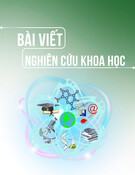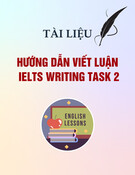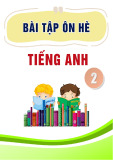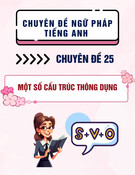
Tạp chí Khoa học Ngôn ngữ và Văn hóa
ISSN 2525-2674
Tập 7, số 3, 2023
263
ANALYZING CHILDREN’S ORAL LANGUAGE
IN AN ENGLISH LANGUAGE ARTS CLASSROOM
Tran Thi Thuy Hang
Ho Chi Minh City University of Technology and Education, Vietnam
hangttt@hcmute.edu.vn
(Received: 16/08/2023; Revised: 10/11/2023; Accepted: 01/12/2023)
Abstract: Grounded on theories of language (Blair, 2000; Britton, 1970; Halliday, 1991;
Vygotsky, 1978), this research aims at analyzing and understanding children’s oral language
in an English Language Arts classroom at an elementary public school in western Canada.
The study was conducted with four Grade 4 students coming from different cultures within
13 consecutive weeks of the semester. Class observations and audio recordings were
employed for data collection to grasp holistic and ethical understandings of their oral
language. Data was analyzed based on color-coded themes, which results in four significant
findings: (1), the diversity of children’s oral language functions; (2), the Participant and
Spectator roles of language in connection to embedded speech and displaced speech; (3), the
interaction of Girl Talk and Boy Talk; and (4), the children’s peer support through Zone of
Proximal Development. This research also showcased that respectfulness for cultural
diversity in classrooms and teacher’s pedagogies and support are beneficial for children’s
language development.
Keywords: children’s oral language, English Language Arts, language function, Zone of
Proximal Development
1. Introduction
Language is always and everywhere with us. It pervades every area of our waking lives –
our family relationships, our friendships, our working relationships, and even our aloneness. And
those of us who carry on lively conversations or write great poetry in our dreams would argue
that language pervades our hours of sleep as well as our hours of waking. With a phenomenon
so vast and complex, so pervasive in human experience, it is no wonder that people the world
over, throughout the centuries, have been asking questions about language – What is it? How
does it work? How did it begin? How does it change? How do we learn it? No wonder, too,
that the searching questions have focused on various dimensions of this complex and often elusive
and unwieldy “beast.” (Lindfors, 1985)
This research is located within the Theory in Language Arts course as a compulsory project
that all doctoral students have to conduct within a semester. As usual, there are 15 weeks during
a semester at Canadian elementary schools, with the first week for orientation and the last week
for the final exams. My cohorts and I entered our fieldwork in the second week and completed
our data collection in the fourteenth week. We were assigned to study the oral language of children
in their English Language Arts classes. I conducted my study with a group of four Grade 4
students in a multicultural classroom at a public school in Alberta, Canada. With a total of 16
students, their class was divided into four groups (four students each) by the teacher during the
first week of semester, before I started meeting them. Together with me, there were the other three
cohorts being in charge of the remaining three groups. Each of us ran our own individual study
on a certain assigned group throughout the semester. Playing and conversations were shared at

Tạp chí Khoa học Ngôn ngữ và Văn hóa ISSN 2525-2674 Tập …, số …, 202…
264
recess time to strengthen the relationship between researchers and the participants. Significantly,
my research aims to respond to these three following questions:
1. How are the language functions used by elementary students during their English Language
Arts (ELA) classes?
2. What are the roles of language seen in the elementary students’ ELA class activities?
3. Are there any other features of language that also contribute to improving language learning of
children?
While there has been little research on deep understandings towards the diversity and
complexity of multicultural children’s oral language (Cameron, 2001), as this study seeks to
answering these research questions, it hopes to contribute to shortening that gap and thus,
supporting children language teaching and learning in diverse landscapes locally and globally.
2. Theoretical framework
This research is grounded in theories of language arts related to elementary-aged children.
Goodman (2003) asserted that "language is a powerful tool with which to think, to communicate
with others, and to explore the universe" (p. 9). Therefore, it is essential to build a strong
foundation for this research on functions of language (Halliday, 1991), roles of language (Britton,
1970), genderlects-Girl Talk and Boy Talk (Blair, 2000), and Zone of Proximal Development
(Vygotsky, 1978).
2.1 Functions of language
According to Halliday (1991), it is identified that language has seven typical functions
including Instrumental language, Regulatory language, Interactional language, Personal
language, Heuristic language, Imaginative language, and Information language (p. 36).
Instrumental language is the language that a child uses as a means of getting things done.
Regulatory language is the one that is used to regulate the behavior of others. Interactional
language refers to the use of language in the interaction between the self and others. Personal
language denotes the child’s intuitive awareness of language as a form of his or her own
individuality. On the other side of personal language is the one called Heuristic model of
language, derived from the child’s knowledge of how language has enabled him or her to explore
their environment. Also relating to the environment but in a different way, the Imaginative model
provides further elements of metalanguage for the child to create his or her own environment with
their feeling of being inclined. The final model is Information language which is also known as
the Representational model. In this language function, “the child is aware that he can convey a
message in language, a message which has specific reference to the processes, persons, objects,
abstractions, qualities, states, and relations of the real world around him (Halliday, p. 39).
2.2 Roles of language
It has not been denied that language has complex roles across all forms of discourse, but in
order to differentiate literary and nonliterary approaches to reading and writing, Britton (1970)
created a great divide of language’s roles into participant role and spectator role. In the participant
role, language is used to get things done such as to purchase or sell items, to persuade or inform
someone on something, or to theorize knowledge. In the spectator role, language is used to grasp

Tạp chí Khoa học Ngôn ngữ và Văn hóa
ISSN 2525-2674
Tập 7, số 3, 2023
265
experiences and feelings through a ‘verbal object’ or work of literature. With children in
classrooms, their spectator role is seen as having an active role in creating meaning, rather than
functioning merely as a passive viewer.
2.3 Genderlects: Girl Talk and Boy Talk
Blair (2000) believes that in the field of sociolinguistics, gender is seen to be “an
arrangement of co-construction created through a complex set of routinized interactions; at the
same time, gender determines and structures the interaction” (p. 2). In her research project with
children at a middle school in Canada, Blair (2000) found that Boy Talk established and
reinforced the power relations when “the boys spoke to each other in loud voices from as far as
three or four rows apart” (p.3). The Boy Talk carries a wide range of purposes from making the
others laugh, getting the others’ attention, to controlling and gaining power. These kinds of
gendered interactions optimize power and solidarity for boys.
On the other side of the coin is Girl Talk, which functions differently from boy talk. In the
language arts classroom, the girls talked about both their activities at hand and also their personal
lives. When there was flexibility in class with pair and group talk, the girls tended to move around
the classroom and talk quietly to each other and were busier than the boys (Blair, 2000). When
the girls reported disagreement, they did not use powerful language like the boys; instead, the
girls used a particular stylistic device to present their argument such as “he-said-she-said” because
using a third person’s opinion to elaborate their thoughts could contribute to easing down any
possible conflicting ideas. With all of these important findings, Blair (2000) emphasizes that
understanding boy talk and girl talk is beneficial for language arts teachers “to address issues of
equity in classrooms through language, literacy, and literature” (p. 8).
2.4 Zone of Proximal Development
In 1978, Vygotsky, in his passion to discover the actual relations of the children’s
developmental process to their learning capabilities, found out a very significant implication
called the zone of proximal development. He defines it as “the distance between the actual
development level as determined by independent problem solving and the level of potential
development as determined through problem solving under adult guidance or in collaboration
with more capable peers” (p. 86).Vygotsky also reinforces that “what is in the zone of proximal
development today will be the actual development level tomorrow” (p. 87), which means what a
child can do with assistance at the present, he or she will be able to by themselves in the near
future. Vygotsky’s (1978) theory of the zone of proximal development has always been an anchor
for teachers, parents and those who are working with children to help them reach their optimal
development.
3. Research methodology
3.1 Participants
In this study, the author worked with a group of four Grade 4 children who come from
diverse cultures: two Asian children, one Canadian child, and one European child. The teacher
and all children were well informed of our study, and we obtained their consent prior to the
beginning of the project. The author also helped four children in my group select their favorite
pseudonyms so that their identity was anonymous, and their confidentiality was protected. Of all

Tạp chí Khoa học Ngôn ngữ và Văn hóa ISSN 2525-2674 Tập …, số …, 202…
266
the children, there were three girls named Yuri, Miya, and Michelle while the only boy was named
Jackson.
The children in this group studied English Language Arts during their everyday lessons
and with diverse topics and activities. But in order to understand their oral language more deeply
but not broadly, the author chose to continuously and consistently follow them every Thursday
afternoon when they were assigned to work on the project called “Building Your Dream
Neighborhood”. Throughout the 13 weeks, they had to collaborate with each other to go from
brainstorming the ideas to making the plan, testing the model, building the neighborhood, and
finally writing about their whole journey. The teacher requested them to follow the procedure and
fill out their handouts from the beginning to the end, but these children had the freedom in curating
their ideas and using different materials for their work such as Legos, craft items, crayons, wooden
sticks, and colored clay. All of these supporting items were always available in a basket at their
group’s workstation.
3.2 Procedure of data collection and analysis
This study employed qualitative approach to the data analysis. Data was collected from
transcripts of audio recordings of 13 weeks during the Fall semester, with 45 mins class of English
Language Arts each week, where the project-based learning was key for classroom activities. Data
was also gathered from class observation in which the author observed the class and took notes
of the children’s interactions during their group work activities.
During their English Language Arts classes, the author sat at the corner table near the
group’s space. Each space consisted of four individual tables grouped together to make a big
square with each student on each side. The four children were well aware of the author’s presence
and activities in their class. There was no other interaction between the author and the children
during the class time.
The audio recordings were transcribed after every week on the field. Transcripts were then
analyzed with color coding method, in which seven rainbow colors were used for seven language
functions (Halliday, 1991): red for Instrumental Language, orange for Regulatory Language,
yellow for Interactional Language, green for Personal Language, blue for Heuristic Language,
indigo for Imaginative Language, and violet for Information Language. For Britton’s (1970) roles
of language, black was used for the Participant role and white for the Spectator role. With Blair’s
(2000) genderlects, brown was chosen for Boy Talk and gray for Girl Talk.
Data were processed using an excel worksheet to help organize the color-coded themes,
calculated them and sorted them in the descending order. In addition, the observation notes were
used to add more information onto the transcripts to ensure a holistic and ethical understanding
of the children’s oral language.
4. Findings and discussion
4.1 The diversity in children’s oral language functions
Throughout the duration of 13 weeks learning the English Language Arts, Personal
Language was used the most among the four children in my group. In particular, three girls and
a boy used their language to express their personal opinions when doing the task of building
something collaboratively. Interestingly, the way they give their opinions can be both direct and

Tạp chí Khoa học Ngôn ngữ và Văn hóa
ISSN 2525-2674
Tập 7, số 3, 2023
267
indirect. For example, when the group started to brainstorm about building a castle, Jackson (the
only boy) directly opposed: I don’t like princess castles really or I don’t want to make this.
Similarly, Yuri expressed her idea straightly: I don’t think we should build a fairy. It is also found
in the findings that there are many tokens of “Yes” and “No” followed by reasons or explanations
during the excerpt when the children expressed their individuality and personality.
Besides, the children applied the art of language when giving indirect perspectives. Miya,
for instance, did not support building a fairy so she indirectly spoke out a beautiful disagreement:
That would be really hard. Her choice of language is nice and polite, which can help in persuading
the others to try another one but not the giant fairy. Personal language is also presented in the
form of a question, which can be seen clearly when Miya asked: Does it really need a tiara? In
this question, the phrase “really need” supported by a strong voice of emphasis could totally cover
the doubtful opinion of this girl about making the tiara.
Another interesting point is that opposing ideas are also expressed using unlovely images
as seen in Jackson’s statement: Fairies are lame. In this scene, the boy continued to not support
building the fairy and he said that the fairies were lame when the legs were broken. Usually, the
fairies are beautiful and perfect in the eyes of children but when the boy did not find it favorite,
he used the word “lame”, which normally goes with the ugly witches. I also felt pleasant to
observe his saying and realized that at this age, children can connect something they do not like
with unattractive images.
As observed and recognized from the transcripts, the second most common function of
language in this children group was Information Language, which is a useful tool in
conversations. Working with this group across the semester, I could see that their information
language aimed to report facts. Taking the example of the group task of planting trees in a garden.
In this activity, Jackson thought out loud the name of the bush that the girls were still arguing:
They are called apple trees. It happened in the same way when they explained the reason why
they should worry when building a staffroom near their imaginative classroom: because they
loved parties and they could not have more party time if a teacher immediately came and told
them to stop.
Coming as the third most common function was the children’s Interactional Language,
which they used to maintain their relationship with friends through a variety of ways such as
calling proper names or making connections between the speaker and the listener. This was seen
when Yuri and Michelle, for example, made an interaction by calling their friend: Miya, we have
to build something together, or when Miya responded in a humming voice: K- Michelle would
you please shut up? Also, Miya called Jackson many times: “Jackson, Jackson” to get his attention
and support. Significantly, their language emphasizes that they are always members of the group
as in “together we make”, or “we have to be building together”.
Besides, Regulatory Language was noticed throughout the project when the children
controlled the behavior of others (Halliday, 1991) and this language function stands as the fourth
most common one. In detail, the most popularly used expression was “let's” as in Let’s build …,
Let’s try … and Let’s make …. Furthermore, the children gave directions to their peers when using
imperative structures such as Use the yellow ones or Follow the yellow brick road.




![Bộ đề trắc nghiệm Tiếng Anh lớp 5 [mới nhất]](https://cdn.tailieu.vn/images/document/thumbnail/2020/20200529/le_1307/135x160/471590714638.jpg)
![Tổng Hợp Ngữ Pháp Tiếng Anh Lớp 9 [Chuẩn Nhất]](https://cdn.tailieu.vn/images/document/thumbnail/2020/20200120/nanhk4/135x160/6881579527087.jpg)


![Đề thi học kì 2 môn Tiếng Anh Lớp 4 [năm học] mới nhất](https://cdn.tailieu.vn/images/document/thumbnail/2016/20160730/uclamhunglevinhtranl/135x160/2961469864777.jpg)
![500 câu trắc nghiệm Tiếng Anh lớp 9 [Kèm đáp án chi tiết]](https://cdn.tailieu.vn/images/document/thumbnail/2016/20160726/nxuanchinh27/135x160/1636584746.jpg)


![Tài liệu Từ vựng tiếng Anh Trung cấp [mới nhất]](https://cdn.tailieu.vn/images/document/thumbnail/2025/20250913/nguyentuan250421@gmail.com/135x160/99491757910839.jpg)
![Tài liệu Từ vựng Tiếng Anh theo chủ đề [mới nhất]](https://cdn.tailieu.vn/images/document/thumbnail/2025/20250913/namdhuet@gmail.com/135x160/83251757753810.jpg)



![Tài liệu Từ vựng tiếng Anh cho bé [chuẩn nhất/mới nhất]](https://cdn.tailieu.vn/images/document/thumbnail/2025/20250731/huadaithesang2509@gmail.com/135x160/18631754013896.jpg)








